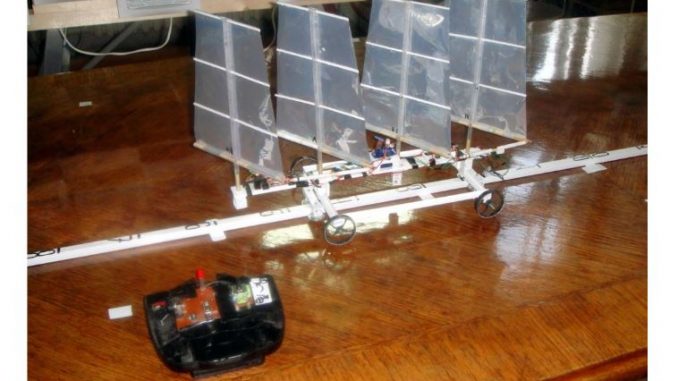
Konstantin Chekarev1,2
1Lomonosov Moscow State University, Moscow, Russia
2E-mail: kostya-chekarev@yandex.ru,
3E-mail: bulungu@yandex.ru
Abstract. Equipment that converts kinetic wind energy into electricity, including floating wind turbines, have large dimensions because of low air density. A variant of a sailing power plant is known, which converts the energy of the wind flow into the energy of a water current, which is used to produce electricity, which allows reducing the size of the energy converter, but the efficiency of power plants decreases at the same time, since part of the energy of the wind flow is spent on moving the sailing vehicle. In addition, there are difficulties in transferring the generated energy to an external consumer. The efficiency of a sailing power plant can be improved if it is installed on the ground. In this case, the movement of a vehicle is used to generate electricity, while the problem of transferring the generated energy to an external consumer is removed. In addition, land-based sailing power plants expand the field of wind energy use. An analysis of possible ways to implement a land-based sailing power plant was carried out, and an experimental installation was created on which mock-ups of sailing power plants were tested in order to verify the functioning of the elements included in the experimental installation and to find structural elements that can be used in the implementation of a land-based sailing installation. The results of these studies are presented in the article.
Keywords: wind power, renewable energy sources, wind plant, sailing power plant.
References
- Global Wind Report 2021 – Global Wind Energy Council. URL: https://gwec.net/global-wind-report-2021 access date 27.06.2022.
- Pervaya v mire plavuchaya ofshornaya vetrovaya elektrostanciya… URL: https://renen.ru/pervaya-v-mire-plavuchaya-ofshornaya-vetrovaya-elektrostantsiya-rabotaet-s-rekordnym-kium/ access date 27.06.2022
- WindFloat Atlantic Project. URL: Power-technology.com/projects/windfloat-atlantic-project access date 27.06.2022
- Cheboksarov V.V., Kuznecov N.N. Gibridnye vetro-solnechnye morskie energeticheskie ustanovki // Stroitel’stvo i tekhnogennaya bezopasnost’. №18(70)-2020. S.67-81
- Solov’yov A.A., Chekarev K.V., Solov’yov D.A. Patent RF № 2 722 760. Parusnaya energeticheskaya ustanovka, preobrazuyushchaya energiyu potokov dvuh sred.
- Chekarev K.V., Degtyarev K.S., Zalihanov A.M. Patent RF № 2 745 173. Parusnaya energeticheskaya ustanovka.
- Chekarev K.V., Zalihanov A.M., Degtyarev K.S. Parusnaya energeticheskaya ustanovka// Geografiya vozobnovlyaemyh istochnikov energii. ID «Energiya», Moskva, 2021. S. 180-197
- Cybul’nikov S.I. Patent RF № 2 125 182 Vetroenergeticheskaya ustanovka
- Kansas Historical Society “Wind Wagon” Archived from the original on July 6 2017.Retrieved 7July 2017. URL: https://www.kansasmemory.org/item/318948 access date 27.06.2022
- Digaj P. Pod parusami po rel’sam. URL: https://www.yachtrussia.com/articles/2016/10/21/articles_391.html access date 27.06.2022
- Chekarev K.V., Zalihanov A.M., Solov’ev D.A, Degtyarev K.S. Wind-driven power machine transforming energy of the two environs // Journal of Environmental Earth and Energy Study (JEEES). № 3. 2020. p.39-46.
